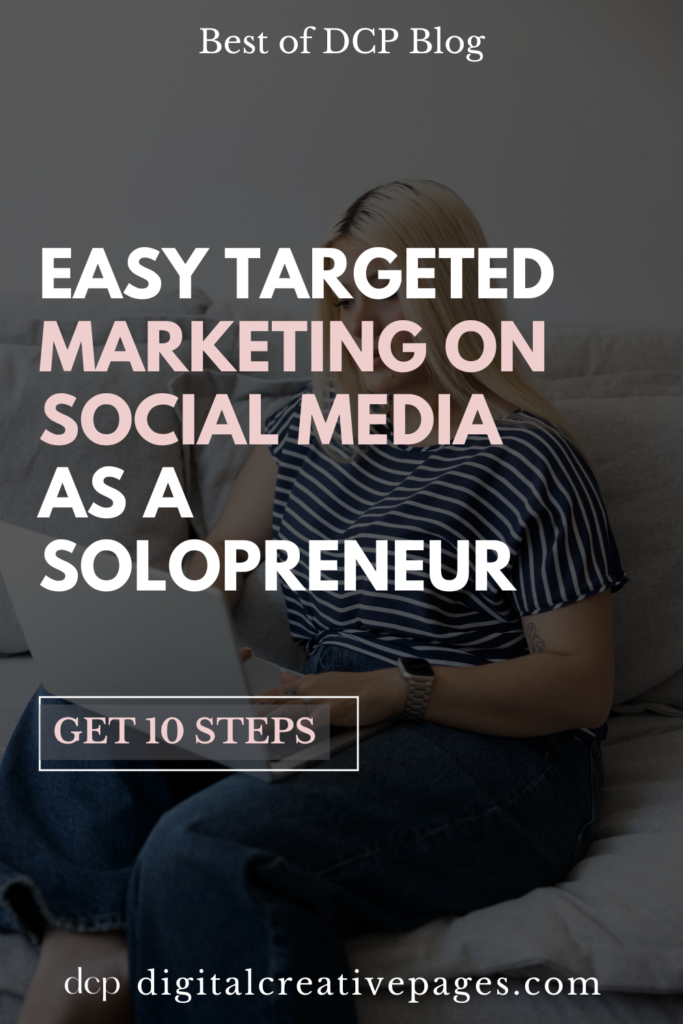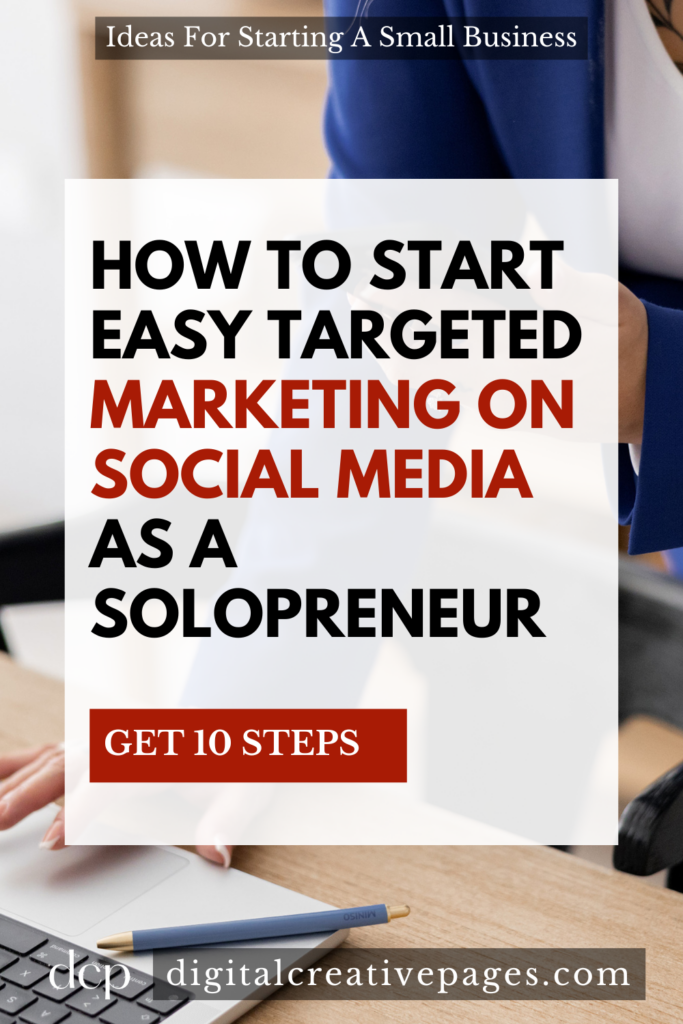Introduction
Starting easy targeted marketing on social media for your small business can feel overwhelming, especially when you have no budget. But here’s the good news—you don’t need money to get started, just a clear, simple strategy. If you’re an absolute beginner who feels lost, stressed, and unsure where to start, this post will take you from zero to confidently marketing your business online.
Pin this for later
Step 1: Choose One Platform and Stick to It
It’s easy to feel like you need to be on every social media platform, but that’s the fastest way to overwhelm yourself. Instead, start with just one platform where your potential customers already spend time. This helps you focus, stay consistent, and actually see results.
- If you sell a visual product (jewelry, art, home decor), Instagram and Pinterest are the best platforms because they highlight aesthetics and discovery.
- If you offer a service (coaching, consulting, freelancing), Instagram and TikTok work well for showcasing expertise and attracting clients. LinkedIn can also be useful for professional networking.
- Facebook groups can be an added benefit for both product and service-based businesses, helping you engage in community conversations and build trust.
Pro Tip: Not sure where to start? Instagram is the safest choice then. It’s versatile, user-friendly, and works for almost every type of business
Step 2: Set Up Your Profile Like a Pro
Think of your social media profile as your business card. If someone lands on your page, they should immediately understand who you are, what you do, and why they should care.
A strong bio should be clear and direct. Use this simple formula: “I help [your target audience] achieve [specific result] through [your product/service].” For example, “I help busy entrepreneurs grow on Instagram with simple, actionable strategies.” Keep it short, specific, and value-driven so potential followers instantly see why they should stick around
- Profile Picture: Use a clear headshot or logo.
- Username: Keep it simple and relevant to your business.
- Bio: One sentence that explains what you do and who you help (Example: “Helping busy moms meal prep in 10 minutes or less”).
- Link: If you don’t have a website yet, link to a free tool like Linktree where you can add multiple links.
Pro Tip: If your name is taken, add “by [Your Name]” or “HQ” to your handle instead of random numbers.
Step 3: Define What You’ll Post (Without Overthinking It)
You don’t need fancy marketing terms like “content pillars” or “brand voice” to start. Just think about what your potential customers need from you. The best way to understand what they want is to pay attention to the questions they ask, the problems they mention, and the struggles they share online.
Check out comment sections, social media groups, and forums related to your industry to see what people are talking about. You can also look at competitors’ posts and see which topics get the most engagement—this gives you insight into what your audience finds valuable.
- Teach Something: Answer common questions about your product/service.
- Show Behind the Scenes: People love to see the real person behind the business.
- Share Customer Wins: Even if you only have one happy client, showcase it!
- Post What You’re Learning: Share your journey—even if you’re just starting.
Pro Tip: Don’t stress about making everything perfect. Your first posts will probably feel awkward, but they’ll get better with practice.
Step 4: Create Content Without Spending Hours
Content creation can be quick and simple if you set up a system. If you’ve never created graphics before, start with free tools like Canva, which offers easy-to-use templates. Pick a few templates that match your brand and tweak them instead of designing from scratch.
Stick to simple fonts, two main colors, and clear text to keep things professional-looking. Over time, you’ll get faster and more confident in designing content that represents your brand well.
- Use Canva (Free): Create graphics and posts easily.
- Batch Your Content: Set aside 1-2 hours a week to make posts in advance.
- Repurpose: Turn one idea into multiple posts (Example: A blog post → Instagram carousel → Twitter thread → Pinterest pin).
- Reuse What Works: If a post does well, tweak and repost it later.
Pro Tip: If writing captions feels hard, pretend you’re texting a friend—keep it casual and real.
Related Post: Instagram Reels Ideas To Boost Engagement
Step 5: Post Consistently (Without Overwhelming Yourself)
Consistency matters more than how often you post. If you can only post twice a week, that’s fine! Just stick to a schedule. Regular posting helps train the algorithm to show your content to more people, making it easier to gain traction over time. It also builds trust with your audience—when they see you showing up consistently, they’re more likely to engage and eventually buy from you.
- Pick a schedule that works for you (Example: Every Monday and Thursday).
- Use Free Scheduling Tools (Like Meta Business Suite for Facebook/Instagram).
- Set a Reminder on your phone so you don’t forget.
- Engage When You Post (Reply to comments, answer DMs).
Pro Tip: It’s better to post twice a week consistently than to post daily for a week and disappear.
Step 6: Get Your First Followers (Without Feeling Awkward)
When you’re new, getting your first 100 followers feels impossible. But you don’t need to go viral—just start with the people you know. However, if you’re running a faceless account or don’t want to tell friends and family, you’ll need a different approach.
Start by engaging in niche communities where your target audience already hangs out. Join relevant Facebook groups, comment on posts, and offer helpful insights—but avoid blatant self-promotion. On Instagram and Pinterest, focus on creating valuable content that naturally attracts your audience.
Growing without personal connections takes time, but consistency is key. Engage with accounts in your niche daily, offer value through your posts, and let your content do the talking. Even in Facebook groups where growth is slow, genuine participation will help build recognition over time.
- Tell Friends and Family: Ask them to follow and share.
- Join Facebook Groups & Comment: Provide value, don’t just promote.
- Follow 20-30 Relevant Accounts: Some will follow you back.
- Engage Genuinely: Comment on others’ posts (not just “great post!” but something meaningful).
Pro Tip: Don’t beg for followers. Focus on creating helpful content, and people will follow naturally.
Related Post: Grow Profitable Business on Instagram
Step 7: Make People Want to Buy (Without Being Salesy)
You don’t need to be pushy to make sales on social media. Instead, focus on building trust and excitement around what you offer. Being too “salesy” means constantly pushing your product without establishing a connection. It can feel forced, repetitive, and impersonal, making potential customers tune out.
To build trust, focus on educating, engaging, and entertaining your audience. Share useful insights, answer common questions, and tell stories about how your product or service genuinely helps people. Instead of just saying “buy now,” show them why your offer is valuable through testimonials, behind-the-scenes content, and problem-solving posts. People buy from brands they trust, not ones that pressure them into making a decision.
- Show Your Product in Action (Demo videos, before/after photos).
- Share Testimonials & Reviews (Even one happy customer is proof!).
- Use Calls to Action (Tell people exactly what to do: “DM me for details!”).
- Offer Limited-Time Promos (Scarcity drives action!).
Pro Tip: People don’t buy from strangers. Engage with them consistently before you pitch.
Step 8: Track What’s Working (Without Fancy Tools)
You don’t need complicated analytics. Just check what posts get the most likes, comments, and shares. If engagement is low, don’t panic—use it as a learning opportunity. Track which posts perform best, note patterns (time of day, format, topic), and adjust your content accordingly. Experiment with different post styles and analyze what resonates with your audience over time.
Instagram provides insights on views and engagement, while Pinterest highlights your top-performing posts. Instagram also suggests trending Reels and posts that are working for other entrepreneurs, while Pinterest offers insights into trending topics. Set aside two hours over the weekend to review these analytics, study trends, and plan seven posts for the coming week on your selected platform.
- Look at Your Last 10 Posts: What got the most engagement?
- Post More of What Works: If a “behind-the-scenes” post did well, do more like that.
- Adjust When Needed: If a certain day/time gets more engagement, lean into it.
Pro Tip: Growth is slow at first. Keep going even if you only get a few likes per post!
Step 9: Collaborate for Faster Growth
When you’re starting, collaborations can expose you to a larger audience without paying for ads. The key is to approach potential collaborators with a message that’s direct, friendly, and mutually beneficial. If you’re reaching out to a big account, keep it short and to the point.
Example DM:
“Hi [Name], I love your content on [specific topic] and admire how you [mention something specific about their brand]. I think our audiences align well, and I’d love to collaborate in a way that brings value to both sides. Would you be open to discussing a simple collaboration, like an Instagram Live or a shoutout swap? Let me know your thoughts—no pressure at all!”
- Partner With Another Small Business (Example: If you sell handmade candles, collab with a self-care brand).
- Do Instagram Live With Someone in Your Niche (Their audience sees you!).
- Guest Post on Their Page (And vice versa!).
- Shout Each Other Out in Stories.
Pro Tip: Collaboration beats competition. Find solopreneurs in similar (but non-competing) niches and grow together.
Step 10: Stay Consistent and Keep Learning
Social media success doesn’t happen overnight. The key is to keep going even when growth feels slow. It’s normal to feel discouraged when engagement is low, but every post is building your brand. Keep refining your strategy, testing new content, and showing up consistently—progress will come.
- Don’t Compare Yourself to big accounts—they started small too.
- Keep Experimenting with new content formats.
- Take Breaks When Needed (Burnout won’t help your business!).
- Celebrate Small Wins (Your first sale, first DM, first 100 followers!).
Pro Tip: Social media changes constantly. Stay flexible and adapt as you grow.
Related Post: New Instagram Trends
Final Thoughts
You don’t need fancy strategies, paid ads, or thousands of followers to make social media marketing work for you. Start simple, stay consistent, and focus on connecting with real people.
Marketing as a solopreneur can feel overwhelming, but remember—you’re not alone in this. Take it one step at a time, and soon, you’ll start seeing real growth.
MY TOP POSTS
Stay connected outside my social media with my weekly Newsletter – Digital Content Pages
My introducer post – check out why I chose Showit as my website builder here
Use my code DCP to get one 1.5 months free on Showit
Get all the resources for your social media and digital marketing without breaking the bank from my DCP Shop here
Pin this for later


